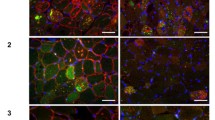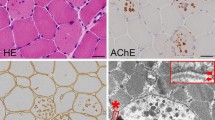Abstract
Autophagic vacuolar myopathies (AVMs) are a group of disorders united by shared histopathological features on muscle biopsy that include the aberrant accumulation of autophagic vacuoles. The classic conditions that compose the AVMs include Pompe Disease, Danon Disease and X-linked myopathy with excessive autophagy (XMEA). Other disorders, including acquired myopathies like chloroquine toxicity, also have features of an autophagic myopathy. This review is focused on XMEA, a myopathy with onset of slowly progressive proximal weakness and elevated serum creatine kinase (2× to 20× normal) typically in the first decade of life. However, both late-adult onset and severe, sometimes lethal, neonatal cases also occur. Skeletal muscle pathology is characterized by numerous cytoplasmic autophagic vacuoles, complex muscle fiber splitting with internalization of capillaries, and complement C5b-9 deposition within vacuoles and along the sarcolemma. The autophagic vacuoles have sarcolemmal features. Mutations in the VMA21 gene at Xq28 cause XMEA by reducing the activity of lysosomal hydrolases. The VMA21 protein regulates the assembly of the V-ATPase required to acidify the lysosome. Increased lysosomal pH and poor degradation of cellular debris may secondarily induce autophagy, the net effect being accumulation of autophagolysosomes. The relationship of XMEA to other lysosomal disorders of muscle and potential therapeutic interventions for XMEA are discussed.


Similar content being viewed by others
References
Chabrol B, Figarella-Branger D, Coquet M et al (2001) X-linked myopathy with excessive autophagy: a clinicopathological study of five new families. Neuromuscul Disord 11:376–388
Choi AMK, Ryter SW, Levine B (2013) Autophagy in human health and disease. N Engl J Med 368:1845–1846. doi:10.1056/NEJMc1303158
Chow G, Beesley CE, Robson K et al (2006) Case of X-linked myopathy with excessive autophagy. J Child Neurol 21:431–433
Crockett CD, Ruggieri A, Gujrati M et al (2014) Late-adult onset of X-linked myopathy with excessive autophagy (XMEA). Muscle Nerve 50(1):138–144. doi:10.1002/mus.24197
Damme M, Suntio T, Saftig P, Eskelinen E-L (2014) Autophagy in neuronal cells: general principles and physiological and pathological functions. Acta Neuropathol. doi:10.1007/s00401-014-1361-4
De Palma C, Morisi F, Cheli S et al (2012) Autophagy as a new therapeutic target in Duchenne muscular dystrophy. Cell Death Dis 3:e418. doi:10.1038/cddis.2012.159
Endo Y, Furuta A, Nishino I (2015) Danon disease: a phenotypic expression of LAMP2-deficiency. Acta Neuropathol [Epub ahead of print]. doi:10.1007/s00401-015-1385-4
Grumati P, Coletto L, Sabatelli P et al (2010) Autophagy is defective in collagen VI muscular dystrophies, and its reactivation rescues myofiber degeneration. Nat Med 16:1313–1320. doi:10.1038/nm.2247
Hansen TE, Johansen T (2011) Following autophagy step by step. BMC Biol 9:39. doi:10.1186/1741-7007-9-39
Holton JL, Beesley C, Jackson M et al (2006) Autophagic vacuolar myopathy in twin girls. Neuropathol Appl Neurobiol 32:253–259. doi:10.1111/j.1365-2990.2006.00691.x
Huynh C, Roth D, Ward DM et al (2004) Defective lysosomal exocytosis and plasma membrane repair in Chediak-Higashi/beige cells. Proc Natl Acad Sci 101:16795–16800. doi:10.1073/pnas.0405905101
Jääskeläinen SK, Juel VC, Udd B et al (2002) Electrophysiological findings in X-linked myopathy with excessive autophagy. Ann Neurol 51:648–652. doi:10.1002/ana.10173
Kalimo H, Savontaus ML, Lang H et al (1988) X-linked myopathy with excessive autophagy: a new hereditary muscle disease. Ann Neurol 23:258–265. doi:10.1002/ana.410230308
Katzin LW, Amato AA (2008) Pompe disease: a review of the current diagnosis and treatment recommendations in the era of enzyme replacement therapy. J Clin Neuromuscul Dis 9:421–431. doi:10.1097/CND.0b013e318176dbe4
Klionsky DJ, Codogno P (2013) The mechanism and physiological function of macroautophagy. J Innate Immun 5:427–433. doi:10.1159/000351979
Kurashige T, Takahashi T, Yamazaki Y et al (2013) Elevated urinary β2 microglobulin in the first identified Japanese family afflicted by X-linked myopathy with excessive autophagy. Neuromuscul Disord 23:911–916. doi:10.1016/j.nmd.2013.06.003
Louboutin JP, Villanova M, Ulrich G et al (1996) Elevated levels of complement components C5 and C9 and decreased antitrypsin activity in the serum of patients with X-linked vacuolated myopathy. Muscle Nerve 19:1144–1147. doi:10.1002/(SICI)1097-4598(199609)19:9<1144:AID-MUS10>3.0.CO;2-V
Louboutin JP, Villanova M, Lucas-Héron B, Fardeau M (1997) X-linked vacuolated myopathy: membrane attack complex deposition on muscle fiber membranes with calcium accumulation on sarcolemma. Ann Neurol 41:117–120. doi:10.1002/ana.410410121
Malicdan MCV, Noguchi S, Nishino I (2007) Autophagy in a mouse model of distal myopathy with rimmed vacuoles or hereditary inclusion body myopathy. Autophagy 3:396–398
Malicdan MC, Noguchi S, Nonaka I et al (2008) Lysosomal myopathies: an excessive build-up in autophagosomes is too much to handle. Neuromuscul Disord 18:521–529. doi:10.1016/j.nmd.2008.04.010
Masiero E, Agatea L, Mammucari C et al (2009) Autophagy is required to maintain muscle mass. Cell Metab 10:507–515. doi:10.1016/j.cmet.2009.10.008
Merlini L, Nishino I, Consortium for Autophagy in Muscular Dystrophies (2014) 201st ENMC International Workshop: autophagy in muscular dystrophies—Translational approach, 1–3 November 2013, Bussum, The Netherlands. Neuromuscul Disord. doi:10.1016/j.nmd.2014.03.009
Minassian BA, Aiyar R, Alic S et al (2002) Narrowing in on the causative defect of an intriguing X-linked myopathy with excessive autophagy. Neurology 59:596–601
Mindell JA (2012) Lysosomal acidification mechanisms. Annu Rev Physiol 74:69–86. doi:10.1146/annurev-physiol-012110-142317
Munteanu I, Ackerley CA, Mnatzakanian GN et al (2005) Electrophysiology extends the phenotypic spectrum of X-linked myopathy with excessive autophagy. Neurology 64:927–928. doi:10.1212/01.WNL.0000152884.11980.53
Munteanu I, Ramachandran N, Mnatzakanian GN et al (2008) Fine-map** the gene for X-linked myopathy with excessive autophagy. Neurology 71:951–953. doi:10.1212/01.wnl.0000325991.01899.35
Munteanu I, Ramachandran N, Ruggieri A et al (2015) Congenital autophagic vacuolar myopathy is allelic to X-linked myopathy with excessive autophagy. Neurology (in press)
Nemazanyy I, Blaauw B, Paolini C et al (2013) Defects of Vps15 in skeletal muscles lead to autophagic vacuolar myopathy and lysosomal disease. EMBO Mol Med 5:870–890. doi:10.1002/emmm.201202057
Nishino I (2006) Autophagic vacuolar myopathy. Semin Pediatr Neurol 13:90–95. doi:10.1016/j.spen.2006.06.004
Parzych KR, Klionsky DJ (2014) An overview of autophagy: morphology, mechanism, and regulation. Antioxid Redox Signal 20:460–473. doi:10.1089/ars.2013.5371
Platt FM, Boland B, van der Spoel AC (2012) The cell biology of disease: lysosomal storage disorders: the cellular impact of lysosomal dysfunction. J Cell Biol 199:723–734. doi:10.1083/jcb.201208152
Ramachandran N, Munteanu I, Wang P et al (2013) VMA21 deficiency prevents vacuolar ATPase assembly and causes autophagic vacuolar myopathy. Acta Neuropathol 125:439–457. doi:10.1007/s00401-012-1073-6
Reifler A, Li X, Archambeau AJ et al (2014) Conditional knockout of Pik3c3 causes a murine muscular dystrophy. Am J Pathol. doi:10.1016/j.ajpath.2014.02.012
Ruggieri A, Ramachandran N, Wang P et al (2015) Non-coding VMA21 deletions cause X-linked myopathy with excessive autophagy. Neuromusc Dis (in press)
Saviranta P, Lindlöf M, Lehesjoki AE et al (1988) Linkage studies in a new X-linked myopathy, suggesting exclusion of DMD locus and tentative assignment to distal Xq. Am J Hum Genet 42:84–88
Spampanato C, Feeney E, Li L et al (2013) Transcription factor EB (TFEB) is a new therapeutic target for Pompe disease. EMBO Mol Med 5:691–706. doi:10.1002/emmm.201202176
Sugie K, Noguchi S, Kozuka Y et al (2005) Autophagic vacuoles with sarcolemmal features delineate Danon disease and related myopathies. J Neuropathol Exp Neurol 64:513–522
Sun-Wada G-H, Wada Y (2013) Vacuolar-type proton pump ATPases: acidification and pathological relationships. Histol Histopathol 28:805–815
Villanova M, Louboutin JP, Chateau D et al (1995) X-linked vacuolated myopathy: complement membrane attack complex on surface membrane of injured muscle fibers. Ann Neurol 37:637–645. doi:10.1002/ana.410370514
Villard L, Portes des V, Levy N et al (2000) Linkage of X-linked myopathy with excessive autophagy (XMEA) to Xq28. Eur J Hum Genet 8:125–129. doi:10.1038/sj.ejhg.5200432
**e Z, Klionsky DJ (2007) Autophagosome formation: core machinery and adaptations. Nat Cell Biol 9:1102–1109. doi:10.1038/ncb1007-1102
Yan C, Tanaka M, Sugie K et al (2005) A new congenital form of X-linked autophagic vacuolar myopathy. Neurology 65:1132–1134. doi:10.1212/01.wnl.0000178979.19887.f5
Author information
Authors and Affiliations
Corresponding author
Rights and permissions
About this article
Cite this article
Dowling, J.J., Moore, S.A., Kalimo, H. et al. X-linked myopathy with excessive autophagy: a failure of self-eating. Acta Neuropathol 129, 383–390 (2015). https://doi.org/10.1007/s00401-015-1393-4
Received:
Accepted:
Published:
Issue Date:
DOI: https://doi.org/10.1007/s00401-015-1393-4




